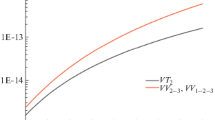Abstract
Classical dynamics methods have been used to study the nonlinear vibrations of a CO2 molecule. Consideration includes not only the anharmonicity valence angle, which enables one to explain the Fermi resonance, but also the physical nonlinearity of the force field (stiffness and softness of springs). In the farthest neighbor approximation (with regard to oxygen–oxygen interaction), a set of nonlinear differential equations in the Lagrangian form has been derived. Their analytical solution has been derived using the method of invariant normalization. The occurrence of a strange attractor has been discovered by numerical simulation. Recommendations for the selection of initial conditions are given that take into account the possibility of regular beatings that change into to chaotic beatings.
Similar content being viewed by others
References
M. V. Vol’kenshtein, M. A. El’shevich, and B. I. Stepanov, Oscillations of Molecules (Gostekhizdat, Moscow, 1949).
G. Herzberg, Infrared and Raman Spectra of Polyatomic Molecules (Van Nostrand, New York, 1947; Izd. Inostr. Lit., Moscow, 1949).
G. T. Aldoshin and S. P. Yakovlev, Izv. Ross. Akad. Nauk, Mekh. Tverd. Tela, No. 32, 42 (2015).
E. Fermi, Z. Phys. 71, 250 (1931).
M. Lacy, Mol. Phys. 45, 253 (1982).
A. G. Csåszår, J. Phys. Chem. 96, 7898 (1992).
A. G. Petrov, Izv. Ross. Akad. Nauk, Mekh. Tverd. Tela, No. 5, 18 (2006).
G. T. Aldoshin and S. P. Yakovlev, in Proceedings of All- Russia Meeting on Fundamental Problems of Theoretical and Applied Mechanics, Kazan’, 2015 (Izd. Kazansk. Federal. Univ., Kazan’, 2015), pp. 109–111.
A. G. Petrov and A. M. Shunderyuk, Izv. Ross. Akad. Nauk, Mekh. Tverd. Tela, No. 2, 27 (2010).
G. T. Aldoshin, Theory of Linear and Nonlinear Oscillations: A Student Book (Lan’, St. Petersburg, 2013).
G. T. Aldoshin and S. P. Yakovlev, in Proceedings of the International Conference on Mechanics 7th Polyakhov’s Readings, St. Petersburg, 2015, pp. 1–4.
E. Simiu, Chaotic Transitions in Deterministic and Stochastic Dynamical Systems. Applications of Melnikov Processes in Engineering, Physics, and Neuroscience (Princeton Univ., Princeton, 2002; Fizmatlit, Moscow, 2007).
A. S. Ledkov, “Investigation of resonant motion of segment- conical bodies in the atmosphere,” Candidate’s Dissertation (Samara, 2009).
L. M. Perko, Rocky Mt. J. Mat. 22, 980 (1992).
J. E. Marsden and T. S. Ratiu, Introduction to Mechanics and Symmetry: A Basic Exposition of Classical Mechanical Systems, 2nd ed. (Springer, New York, 1998).
Author information
Authors and Affiliations
Corresponding author
Additional information
Original Russian Text © G.T. Aldoshin, S.P. Yakovlev, 2016, published in Zhurnal Tekhnicheskoi Fiziki, 2016, Vol. 86, No. 12, pp. 25–32.
Rights and permissions
About this article
Cite this article
Aldoshin, G.T., Yakovlev, S.P. Mechanical model of carbon dioxide vibrational spectrum. Tech. Phys. 61, 1789–1796 (2016). https://doi.org/10.1134/S1063784216120033
Received:
Accepted:
Published:
Issue Date:
DOI: https://doi.org/10.1134/S1063784216120033



